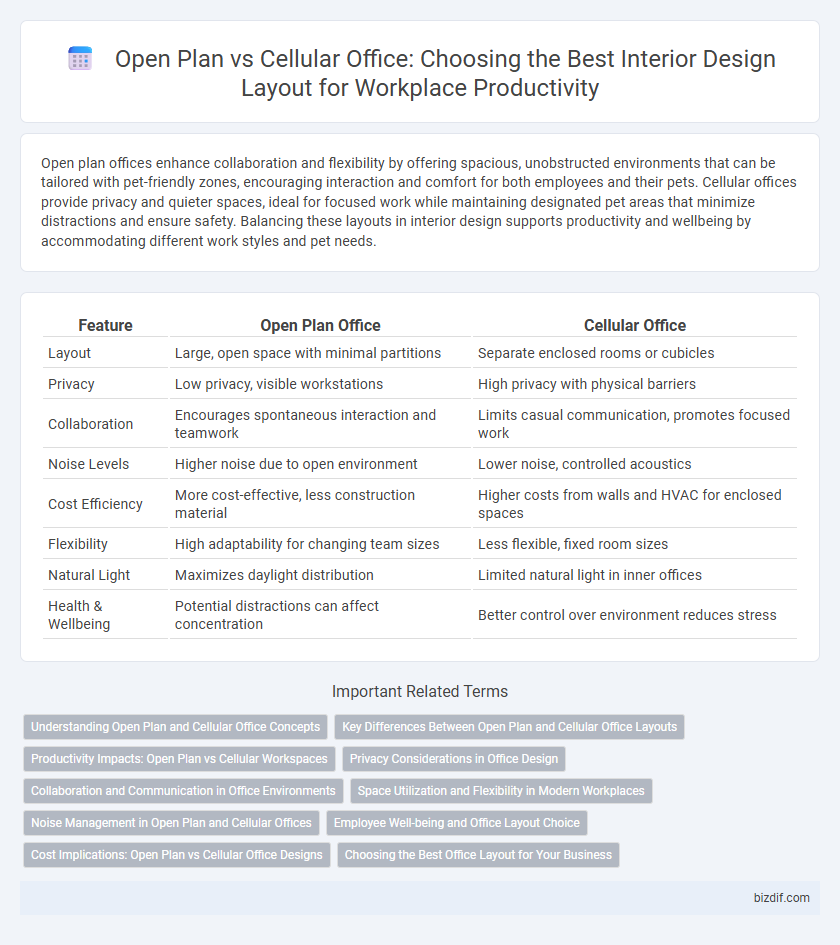Open plan offices enhance collaboration and flexibility by offering spacious, unobstructed environments that can be tailored with pet-friendly zones, encouraging interaction and comfort for both employees and their pets. Cellular offices provide privacy and quieter spaces, ideal for focused work while maintaining designated pet areas that minimize distractions and ensure safety. Balancing these layouts in interior design supports productivity and wellbeing by accommodating different work styles and pet needs.
Table of Comparison
| Feature | Open Plan Office | Cellular Office |
|---|---|---|
| Layout | Large, open space with minimal partitions | Separate enclosed rooms or cubicles |
| Privacy | Low privacy, visible workstations | High privacy with physical barriers |
| Collaboration | Encourages spontaneous interaction and teamwork | Limits casual communication, promotes focused work |
| Noise Levels | Higher noise due to open environment | Lower noise, controlled acoustics |
| Cost Efficiency | More cost-effective, less construction material | Higher costs from walls and HVAC for enclosed spaces |
| Flexibility | High adaptability for changing team sizes | Less flexible, fixed room sizes |
| Natural Light | Maximizes daylight distribution | Limited natural light in inner offices |
| Health & Wellbeing | Potential distractions can affect concentration | Better control over environment reduces stress |
Understanding Open Plan and Cellular Office Concepts
Open plan offices feature large, open spaces with minimal partitions, promoting collaboration and flexibility, while cellular offices consist of individual enclosed rooms providing privacy and noise control. Understanding the balance between these concepts is crucial for optimizing workspace functionality and employee well-being. Choosing between open plan and cellular layouts depends on factors such as company culture, nature of work, and communication needs.
Key Differences Between Open Plan and Cellular Office Layouts
Open plan offices emphasize collaborative spaces with minimal partitions, enhancing communication and flexibility, while cellular office layouts provide individual enclosed rooms that prioritize privacy and focused work. Open plans often feature shared desks and communal areas, promoting teamwork, whereas cellular offices reduce noise distractions and cater to confidential tasks. The choice impacts employee interaction, concentration levels, and spatial utilization in workplace design.
Productivity Impacts: Open Plan vs Cellular Workspaces
Open plan offices encourage collaboration and communication, often boosting creativity and teamwork but can lead to increased distractions and decreased individual productivity. Cellular offices provide private, enclosed spaces that enhance focus and reduce noise, supporting tasks requiring concentration and minimizing interruptions. Research indicates that a hybrid approach, integrating both layouts, may optimize productivity by balancing openness with privacy.
Privacy Considerations in Office Design
Open plan office designs prioritize collaboration but often compromise acoustic privacy and visual concentration, resulting in frequent distractions and reduced employee focus. Cellular offices, featuring enclosed spaces, provide superior sound insulation and visual privacy, enhancing confidential communication and individual productivity. Balancing privacy needs in office design involves incorporating sound-absorbing materials and strategically positioned partitions to optimize both openness and seclusion.
Collaboration and Communication in Office Environments
Open plan offices enhance collaboration and communication by removing physical barriers, fostering spontaneous interactions and team synergy. Cellular offices provide private, quiet spaces that reduce distractions, allowing focused individual work, but may limit face-to-face exchanges. Balancing open plan design with designated quiet zones can optimize both collaborative engagement and concentrated productivity.
Space Utilization and Flexibility in Modern Workplaces
Open plan offices maximize space utilization by eliminating walls, fostering collaboration and adaptable layouts that can be easily reconfigured for different team sizes or activities. Cellular offices offer privacy and dedicated zones but often result in underutilized square footage due to fixed partitions and less flexible arrangements. Modern workplaces prioritize open plan designs to enhance flexibility, optimize space, and support dynamic work styles while integrating quiet zones for focused tasks.
Noise Management in Open Plan and Cellular Offices
Open plan offices often struggle with noise distractions due to the lack of physical barriers, leading to decreased concentration and productivity. Cellular offices provide sound isolation through enclosed spaces, effectively minimizing noise disturbances and supporting focused work. Acoustic treatments such as sound-absorbing panels and strategic furniture placement can improve noise management in open plan environments.
Employee Well-being and Office Layout Choice
Open plan offices foster collaboration and natural light exposure, enhancing employee well-being by reducing feelings of isolation; however, noise and distractions may impair focus. Cellular offices provide personalized, quiet workspaces that support concentration and privacy, positively impacting mental health but potentially limiting social interaction. Choosing between open plan and cellular layouts depends on balancing teamwork needs with individual work preferences to optimize overall productivity and well-being.
Cost Implications: Open Plan vs Cellular Office Designs
Open plan offices generally reduce construction and furnishing costs by minimizing partition walls and maximizing shared spaces, leading to lower overall expenses compared to cellular offices. Cellular office designs, with individual enclosed rooms, increase material, labor, and maintenance costs due to added walls, doors, and HVAC requirements. However, higher initial costs in cellular offices might be offset by increased privacy and reduced noise distractions, potentially enhancing employee productivity and reducing turnover expenses.
Choosing the Best Office Layout for Your Business
Choosing the best office layout for your business depends heavily on your company's workflow and culture, with open plan offices promoting collaboration and cellular offices enhancing privacy and focus. Open plan layouts optimize space utilization and foster communication, ideal for startups and creative industries, while cellular offices provide individual workspaces better suited for tasks requiring concentration and confidentiality. Factors such as employee interaction, noise levels, and flexibility should guide the decision to ensure a productive and comfortable work environment.
Open Plan vs Cellular Office Infographic

 bizdif.com
bizdif.com